When looking for the best free software for web design, there are a few things to keep in mind. In this post, I‘m going to walk you through everything you need to know to use the best tools that will allow you to create an engaging, user-friendly website. Then, I’ll share some that you can try yourself.
Table of Contents
- Summary: Free Software Web Design
- What is website design software?
- Best Web Design Software: Features to Look For
- Best Free Web Design Software
- How to Choose the Best Website Design Software
- Get Started Today
- Frequently Asked Questions: Free Software Web Design
Summary: Free Software Web Design
Free web design software assists both beginners and skilled users in creating the layout, wireframe, mockup, or prototype of a website — basically, how it will look. Examples include Figma, Sketch, and Fluid UI. Some web design software solutions also dip into the development part, which is where you translate the design into a working website that you can launch to the public. All-in-one website builders like HubSpot Content Hub help you design a site, build it, and launch it to the public without needing to code. Ready to build your website? Get started for free with Content Hub.
|
Web Design Software |
Best |
Features |
Limitations |
Pricing |
|
Content Hub |
All-in-one web design software for beginners |
Free website maker, drag-and-drop builder, team collaboration, content management. URL mapping, analytics reporting, AI tools (including an AI website builder, content generation, and more), user registration and membership |
Free plan includes HubSpot branding, premium plans might be pricier than other options in this list, limited customization beyond the templates |
Starter plan: $9/month/seat. Professional plan: $450/month with 3 seats included. Enterprise plan: $1,500/month with 5 seats included |
|
WordPress |
Open-source web design software |
Content management, pre-made website design themes, visual drag-and-drop design experiences, user registration and membership, Integrations for many third-party services (including HubSpot) |
WordPress CMS is free, but you still must pay for good hosting. Plugin and template costs can add up. You'll be responsible for basic maintenance unless you pay for a maintenance service. You must handle website performance optimization yourself. |
Free. |
|
Wix |
Simple website builder |
Drag-and-drop web design, pre-made website templates, AI website builder option, user registration and membership, ecommerce and online payments, third-party app marketplace for extensibility |
Wix’s free offering requires Wix branding in your site’s URL. Less flexible than WordPress (for example, you’re unable to switch to a different template once you’ve started building). |
Light plan: $17/month. Core plan: $29/month. Business plan: $39/month. Business Elite plan: $159/month. |
|
Fluid UI |
Simple free web design software for prototyping |
User interface design, interactive prototypes, asset hosting and storage, team collaboration features, works in a web browser or a desktop client |
The free version is limited — you’re allowed one project with 10 pages and one user. It is less ideal for higher-fidelity designs, as it's meant for fast, iterative prototypes. |
Free plan available. Solo plan: $99/year. Pro plan: $229/year. Team plan: $499/year. |
|
Dorik AI |
Code-free AI web design software |
AI text and image generation, white-label CMS, custom fields and collections, regenerate any layout, built-in hosting and CDN, payment processing |
Limited ecommerce functionalities. The design customization tools are not as powerful as other website builders, in my experience. |
Free plan available. Personal plan: $20.75/month. Business: $41.50/month. For Agency pricing, you have to contact Dorik for details. |
|
Figma |
Free collaborative wireframing tool for beginners |
User interface design, interactive prototype functionality, design libraries to ensure consistency across your entire project, commenting and real-time collaboration, third-party community resources |
The free version is slightly limited. The free plan only tracks 30 days of version history, which might be too little for larger projects. Can experience performance issues, especially over weaker connections. |
Free Starter plan available. Professional plan: $16/month for a full seat. Organization plan: $55/month for a full seat. Enterprise plan: $90/month for a full seat. |
|
Sketch |
User interface design tool for Mac users |
User interface design, collaboration with other team members, desktop software (no internet connection needed), component sharing, developer hand-off tools for web browser (no Mac needed for this part) |
Free trial only (30 days), macOS only, weaker collaboration features than other options on this list. |
Standard plan: $12/editor/month. Business plan: $24/editor/month. Mac-only licenses: $120/seat. |
What is website design software?
Website design software is any type of software that can help you with some or all of the process of designing and launching a website, including wireframing, prototyping, building, and editing all of the visual elements that make up a site.
On one end, you have full website builder tools such as Content Hub, Wix, and WordPress, which are full-service solutions that can help you design, create, and manage a working website.
On the other end, you have tools such as Figma and Sketch that are focused on helping you create the design for your website. However, once you have that design, you need to find a different solution to turn it into a working website, whether that's using a content management system (CMS) or coding it from scratch.
Website Builders vs Design Tools
A website builder actually creates the functional, public website that your visitors will use. Usually, website builders are no-code, meaning you can use a visual editor to design and launch the site.
General web design tools do not necessarily create a fully-functional, public-facing site. They focus on the web page design. Design tools include Figma and Sketch, which can create wireframes, mockups, and prototypes that help in the design phase before you hit the development phase, where you actually code the site into reality.
Who Needs Web Design Software
All sorts of people involved in the making of a website need web design software. These can be professionals like web designers and web developers, or beginners, such as a solo business owner. If you identify with the latter, be sure to read our article on the best website builders for small businesses.
Professional web design software like Figma and Sketch are useful for web designers. But for non-web designers, tools like Content Hub and Wix (both website builders) are more useful.
Free vs Paid Options
Here are some web design software tools with free options:
- Content Hub
- Figma
- Wix
- Dorik AI
Here are some web design software with paid options (you’ll see some overlap with the above list!):
- Content Hub
- Figma
- Wix
- Dorik AI
- Sketch
In this post, I’ll include different types of web design software so that there’s something for everyone. Basically, whether you’re just looking for an offline tool to help you with design, an AI tool to do the work for you, or you’re looking to actually build and launch a website, you'll find some great options on this list.
Best Web Design Software: Features to Look For
What makes the best web design software so effective? When considering different web design tools, here are a few capabilities and features I think are important to look out for.
Visual Editor
Web design primarily focuses on the visual aspect of websites, as opposed to the content management or development side. As such, good web design software should include a visual editor that allows you to design seamlessly. There's no need to touch actual code (unless you want to).
All of the software on my list has a visual editor. If you are looking to interact with your website and make changes without knowing how to code, a good visual editor is a must.
Templates
A piece of great web design software will offer you a point to work off. Because this type of software is meant to be beginner-friendly, you shouldn’t have to start from scratch. That’s where templates come in.
The best web design software will offer various templates for you to create a site that looks and feels the way you envision it. Templates are also beneficial for designers who are just starting out and want something to build on.
It’s also important that the design software you choose has a template design that you actually like. Would you rather have a million templates to choose from that you’ll never use? Or one beautiful template that you know will help you make the most of your website?
AI Website Design Tools
With the rise of AI, a lot of web design software tools have started incorporating AI functionality into their feature set.
Personally, I don’t think AI is currently capable of building an entire website from scratch. That is, I haven’t seen any AI website builders that can take a text prompt and turn it into a complete website that I would be proud to share with people without any adjustments.
However, AI can help with many parts of the web design process, which is why I think it's helpful to look for web design software with built-in AI functionality.
I recommend looking for functionality to generate images, text, code, and maybe even basic layouts. These features won't build a beautiful website by themselves, but they will be able to speed up the web design process.
A quality AI website builder can also work as a great jumping-off point. I just wouldn't recommend using the AI website as is … yet, at least.
Fonts and Graphics
You shouldn’t feel short-changed when trying to use a free web design tool. It’s imperative that you have access to the fonts and graphics you need to create a stunning prototype or wireframe. Your web design tools should offer you plenty of options for fonts and graphics. If they don’t, you should look for an alternative. Check out our list of the best graphic design software, too.
Some web design tools will also include hosting services, SSL certificates, content management tools, and domain names. Others will only offer tools for wireframing and visual design. And still others are only designed for writing code.
Whether you’re looking for an all-in-one solution or a standalone design tool, I’ve got you covered with this list of top web design software.
Best Free Web Design Software
With so many tools available, it can be overwhelming to decide which are worth your time. That’s why I’ve reviewed and curated a list of some of the best free software for web design.
To make it easier for you to find the best tool for your specific situation, I'll divide this list into four subsections:
- Best Free Web Design Software for Beginners
- Simple Free Web Design Software
- Code Free Web Design Software
- Professional Web Design Tools
Let’s begin.
Best Free Web Design Software for Beginners
Top pick: Content Hub makes a great option for all-in-one web design software. You can build your site using templates or AI and customize everything using a code-free interface. Beyond web design, you also get lots of marketing, sales, and service features to help make your website a success, making it a great option for businesses looking for the best website builder for growth.
1. Content Hub: Best All-in-One Web Design Software for Beginners
Pricing: Free plan available. Based on annual billing, the Starter plan is $9/month/seat, Professional is $450/month with 3 seats included, and Enterprise is $1,500/month with 5 seats included.
OS: Any (web-based)
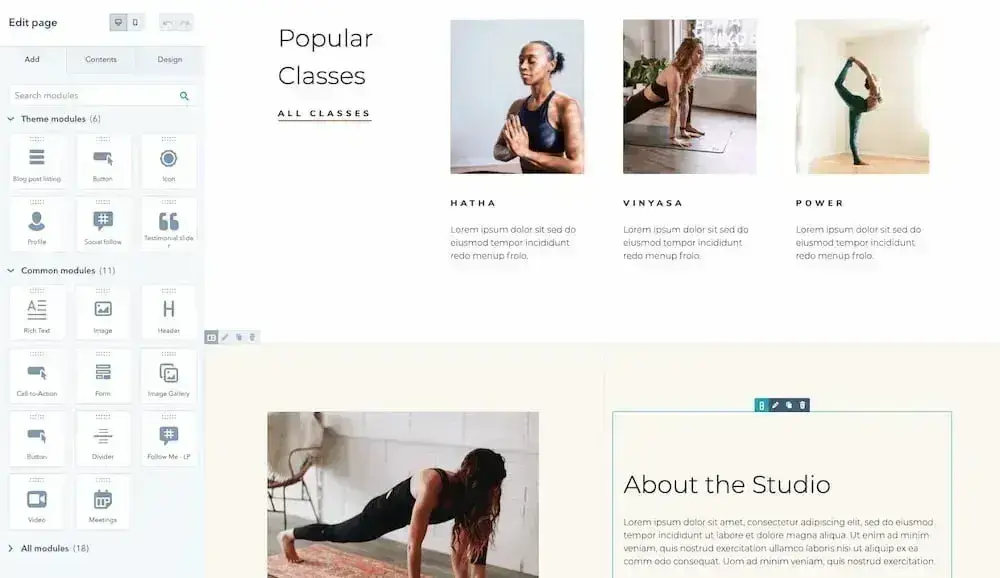
Get started with Content Hub for Free
If you're seeking a website builder and content management system, Content Hub is my top choice. Some of its main features include a visual drag-and-drop editor, a robust collection of templates, and even an SSL certificate. Because using a CMS requires zero coding knowledge and provides everything you need to launch a website, Content Hub comes out on top as the best all-in-one design software for beginners.
Content Hub is also integrated with all other products in the HubSpot platform, including the CRM, marketing software, sales software, and service software. That means instead of having to, say, get a separate email marketing software to send weekly newsletters to your readers — you can do it all within HubSpot.
According to Sean Landry, principal product designer at HubSpot, Content Hub is an excellent choice of web design tools because of how comprehensive it is.
“HubSpot offers an all-in-one solution,” he says. “Since the CMS is part of the platform, it keeps your content and your customers in the same place. Knowing how your customers are interacting with your content allows for seamless data management and automation across Sales, Marketing, and Customer Service.”
Here's a look at my own Content Hub website from start to finish.

I love that Content Hub is great for someone like me who has literally run away at the sight of Python and Java. I don’t have to do any coding, and I can be absolutely sure that I’m not skipping any steps.
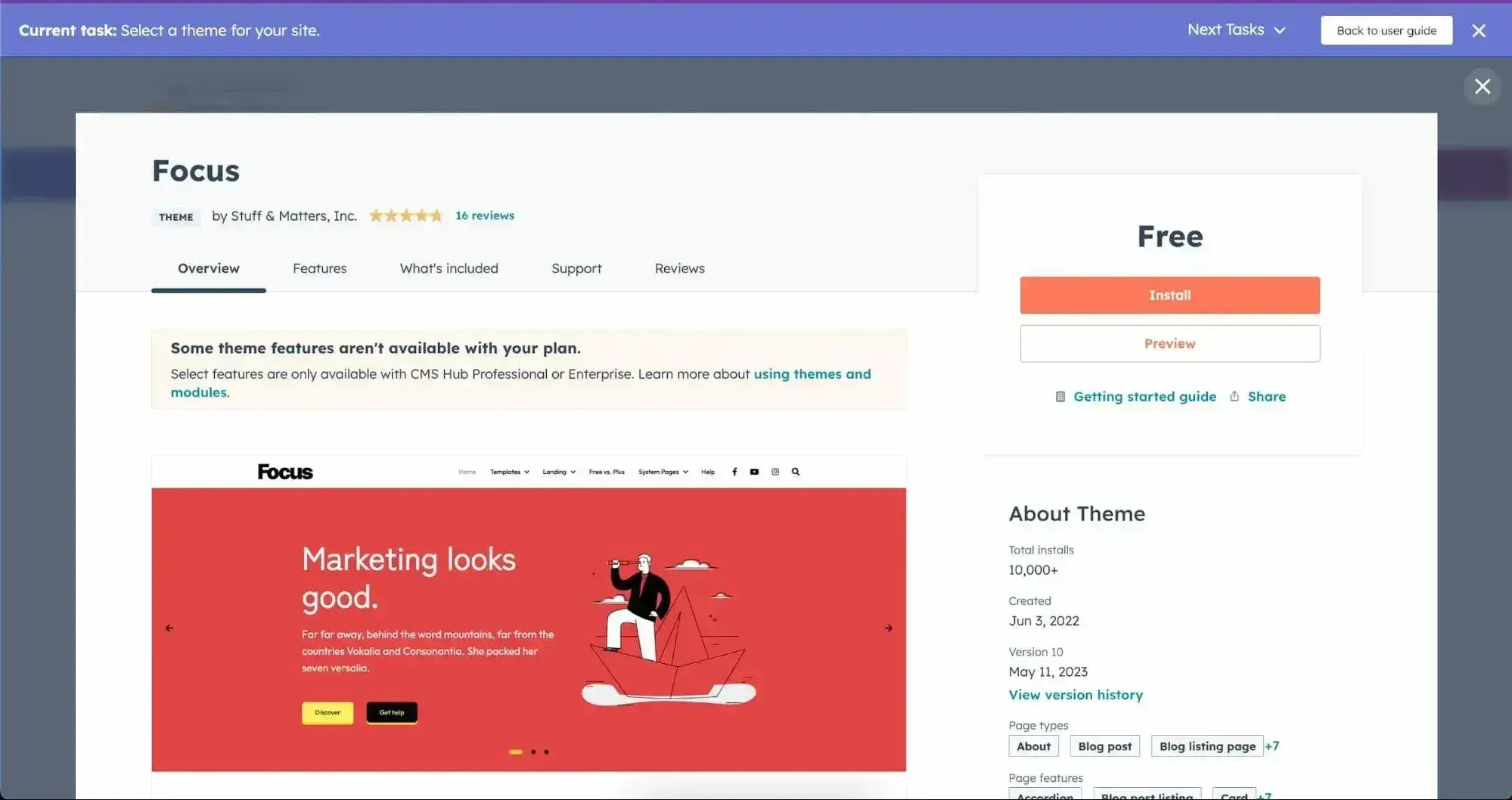
After installing my theme, the world is my oyster. I get to pick between some landing pages, an about, a contact, and a homepage. Just for fun, let's see what the “landing page — coming soon” page looks like.
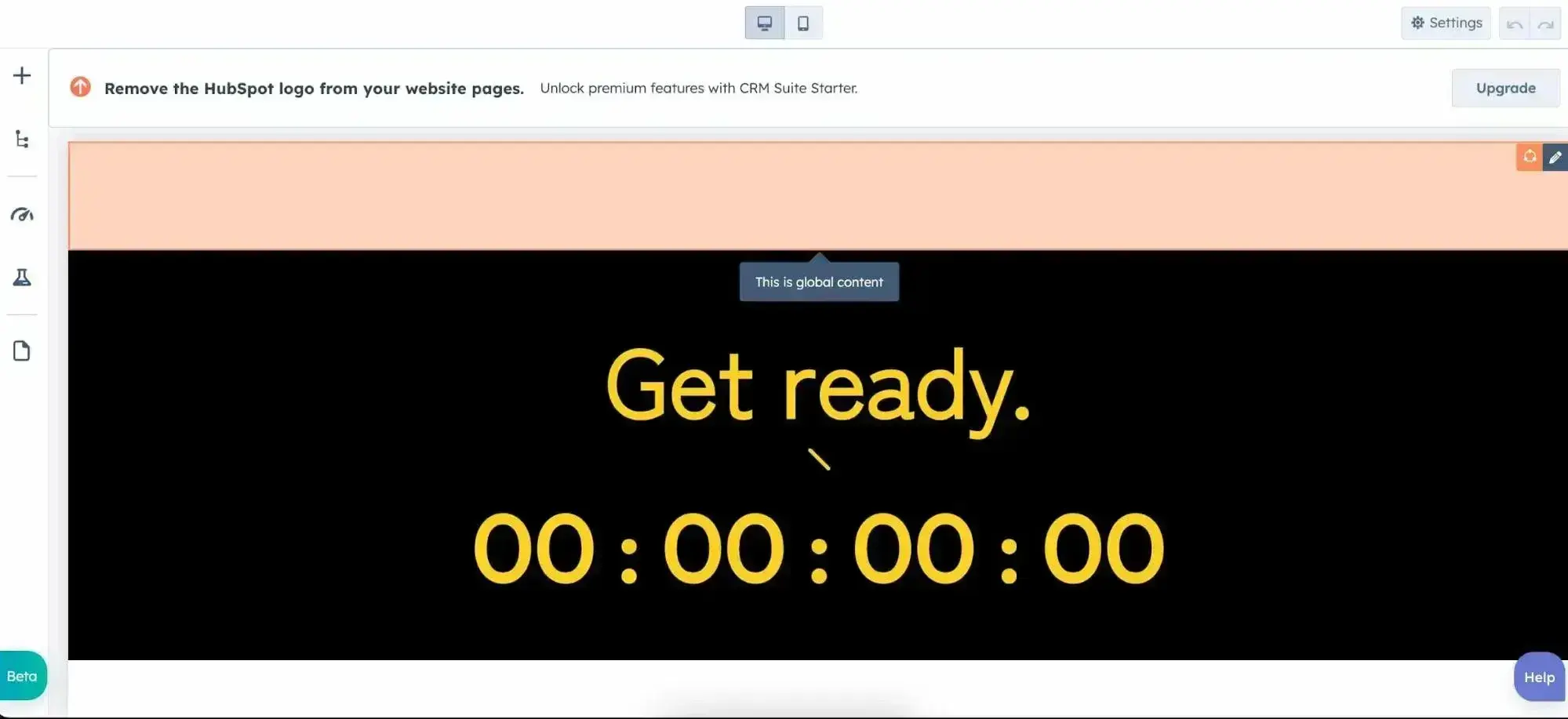
Everything on this page is customizable, and I love the timer widget. The bottom line with Content Hub is that every part of building a website is thought of for you. All you have to do is click through and decide what you want, then customize each page for your project.
This can be a blessing and a curse, and it mostly depends on your coding experience/what you want to do with your website. If you’re a newer web developer, this is the perfect experience for you. If you’re more experienced and want to add unique customization, you'd be better off with one of the other options on this list.
If you want an even simpler experience, Content Hub also launched its own AI website generator that can help you get up and running with a basic website.
You can check out the Content Hub web design inspiration showcase to see some real-world examples of what it can do.
Content Hub Core Functionalities
- Free website maker
- Drag-and-drop builder
- Team collaboration
- Content management
- URL mapping
- Analytics reporting
- AI tools, including an AI website builder, content generation, and more
- User registration and membership
Content Hub Pros
- Comprehensive content management system
- No coding is required with an easy drag-and-drop page builder
- A healthy selection of templates
- Seamless integration with the rest of the HubSpot CRM platform
- Hosting is included
- Built-in access to other AI tools, including content writing tools
- Tons of options for website personalization, which is great for creating better experiences for your visitors
Content Hub Cons
- The free plan includes HubSpot branding.
- If you opt for a premium plan, it may be more costly than other options listed that offer paid plans (though this includes hosting costs)
- You don't get much customization beyond what is given through the templates
Why I Picked It
Content Hub offers a full-service solution for web design, which can save you time and simplify your setup. If you want one tool to both design and build a website, it’s a great one to consider. Thanks to the integration with the free HubSpot CRM, you get access to lots of advanced marketing tools that you won’t find in many other website builders.
Content Hub is the perfect solution for beginners and small businesses. You don’t need a big team to get a beautiful website up and running. The most obvious benefit is getting built-in integration with the HubSpot CRM platform. I’d recommend this to any solopreneur, small to medium business, and/or anyone just curious about starting a website.
2. WordPress: Best Open-Source Web Design Software
Pricing: Free
OS: Any (web-based)
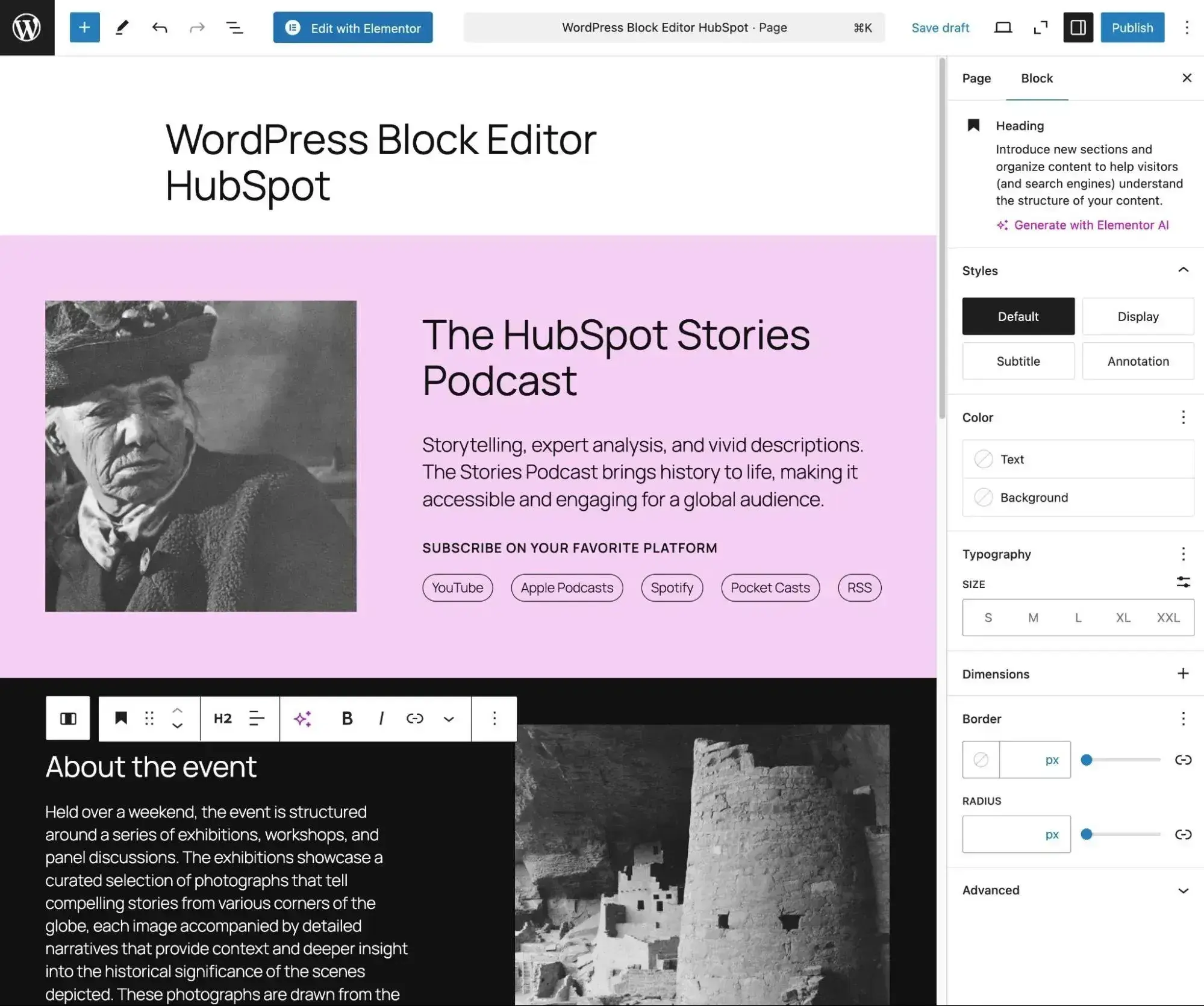
WordPress is an open-source content management system that makes it easy to set up a website in minutes.
There are thousands of free plugins available to download and install so that you can extend the functionality of your site. By taking advantage of plugins, the entire site customization process is streamlined. In other words, you don't need coding skills to start designing.
It‘s important to note that WordPress is free to use, but there are other costs associated with building and running a site on the platform. For example, you’ll need to purchase your own web hosting at the absolute minimum. Read our WordPress cost breakdown for more information.
You can find free WordPress hosting, but I don't recommend free hosting for a serious website. Outside of hosting, though, you can build a very functional website using just the free software and free plugins and themes.
Landry shares some of his favorite WordPress features, including how the tool is “free to use, [and has] lots of available tools to either host your own site or use a hosted solution. They have a large community of users to help troubleshoot problems and an extensive library of plugins that makes extending your site really easy without needing to know how to code.”
If you’ve ever even thought about building a website, you’ve heard of WordPress. The astounding number of plugins and themes can be intimidating to a newcomer, but seasoned veterans will find the number of options preferable.
If you want to install your own plugins and themes, you'll need to either self-host the WordPress software on your own web hosting or choose a paid plan at WordPress.com.*
*“WordPress” and WordPress.com are different — you can learn about those differences here.
I also love how many different design experiences there are for WordPress. For example, here's what it looks like to use the popular Elementor visual builder.
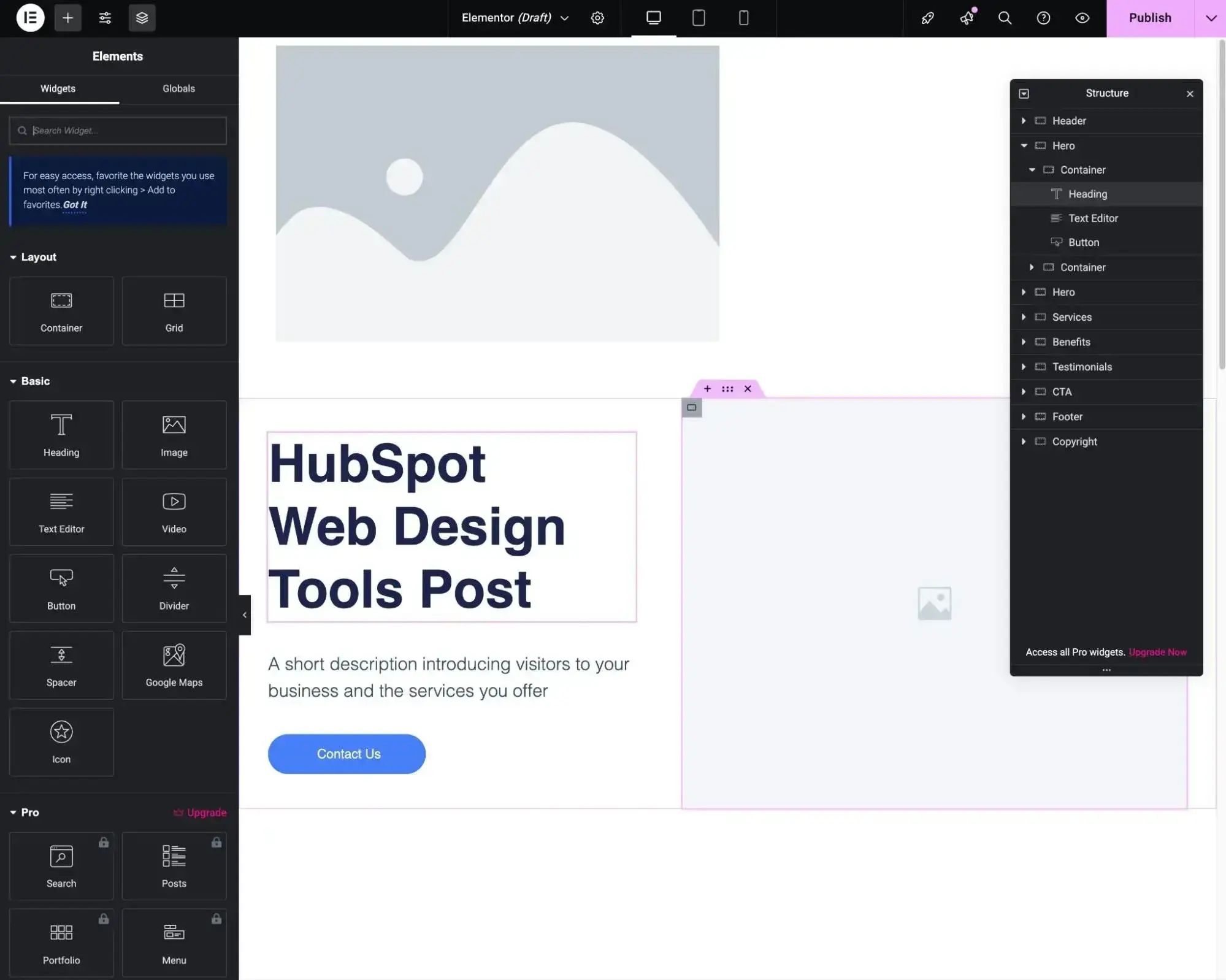
WordPress Core Functionalities
- Content management
- Pre-made website design themes
- Visual drag-and-drop design experiences
- User registration and membership
- Integrations for many third-party services, including HubSpot
WordPress Pros
- Most popular CMS on the internet — a massive 43% of the internet uses WordPress
- Since WordPress.org is not a host, you’re not locked into one web host; you can migrate your site elsewhere
- Highly customizable and configurable thanks to its open-source build
- You can find thousands of pre-made themes, or you can design your own from scratch
- There are 60,000+ free plugins to extend WordPress in all kinds of ways, plus tons of additional premium plugins
- SEO-friendly with built-in integration and plugins to help maximize your search ranking
- Can easily access AI functionality via WordPress plugins
- Lots of different web design plugins, including visual builder plugins like Elementor
- Can easily integrate with marketing tools that you're using, such as HubSpot
WordPress Cons
- The WordPress CMS is free, but you’ll still have to pay for good hosting
- You can rack up the costs with plugins and templates, depending on your website's needs
- You'll be responsible for basic maintenance, unless you pay for a maintenance service
- You need to handle website performance optimization yourself — check out our website optimization checklist to learn what you'll need to do
Why I Picked It
WordPress gives you a lot of flexibility when building a website. It also lets you access many additional web design tools via third-party page builder plugins such as Elementor and Divi, which give you a ton of options for designing your website. Basically, I think it's hard not to include one of the most flexible website-building/designing tools.
I think WordPress can be a good option for individuals and businesses who want the most flexibility and ownership. This is because you can self-host the WordPress software on your own web hosting and easily extend it with thousands of themes and plugins.
However, if you're looking for the absolute simplest website design experience out there, you might be happier with one of the SaaS website design tools on this list, such as HubSpot Content Hub or Wix.
3. Wix: Best Simple Website Builder
Pricing: Based on annual billing, the Light plan is $17/month, Core is $29/month, Business is $39/month, and Business Elite is $159/month. There’s a 14-day money-back guarantee.
OS: Any (web-based)

An affordable, easy-to-use WordPress alternative, Wix is a website builder offering free and premium plans. Similar to WordPress, Wix makes it possible to build all kinds of sites, including stores and blogs, in just a few minutes. But, the experience of managing a Wix site will be very different from WordPress.
Most notably, Wix is a hosted SaaS website builder, rather than self-hosted software like WordPress. Instead of needing to install software onto your own web hosting like WordPress, Wix will handle everything for you, including updates, maintenance, backups, security, and so on.
I think that this can make it a better option for non-technical users, which is why I chose it as the best simple website builder.
Wix has also really embraced AI, which I think makes it a good option for people who are interested in AI web design software. If you don’t want to design your website yourself, you can use Wix’s AI website builder to generate one for you.
There are some downsides to Wix, which I'll discuss in the “Cons” section below. But if simplicity is what you're after in web design software, Wix should definitely be on your shortlist.
Wix Core Functionalities
- Drag-and-drop web design
- Pre-made website templates
- AI website builder option
- User registration and membership
- Ecommerce and online payments
- Third-party app marketplace for extensibility
Wix Pros
- Simple drag-and-drop website builder aimed at helping anyone build a high-quality online presence
- Wix handles hosting and security for you, unlike a tool like WordPress
- More than 2,000 website templates
- If you don‘t want to design your site yourself, there’s also an AI website builder option
- Built-in (and many AI-powered) tools for marketing, ecommerce, and more
- The third-party app marketplace gives you access to lots of features and integrations
Wix Cons
- Wix’s free offering is pretty bare-bones and requires Wix branding in your site’s URL
- Less flexible than WordPress — for example, you’re unable to change to a different site template once you’ve started building, though you can freely tweak your site via its drag-and-drop editor or create a new site whenever
- Wix doesn‘t make it easy to export your site’s content, which might be an issue if you ever want to change web design software in the future
Why I Picked It
Wix is one of the top options if you want an all-in-one website builder and web design tool. I also think Wix is worth including because of its focus on AI web design tools, as it was one of the first website builders to embrace AI, and it remains one of the leading AI website builders today.
Wix is a popular choice for many web developers’ very first website. It’s incredibly easy and simple to get something started with no extra cost. I’d recommend this tool for beginner web enthusiasts who want to build a simple website for their hobbies or perhaps even a personal portfolio website. However, once you want more functionality from your website, I’d switch to Content Hub or WordPress, depending on your needs.
Simple Free Web Design Software
4. Fluid UI: Best Simple Free Web Design Software for Prototyping
Pricing: Free plan available. Based on annual billing, the Solo plan costs $99 a year. Pro plan costs $229 a year. Team plan costs $499 a year.
OS: Any (web-based)
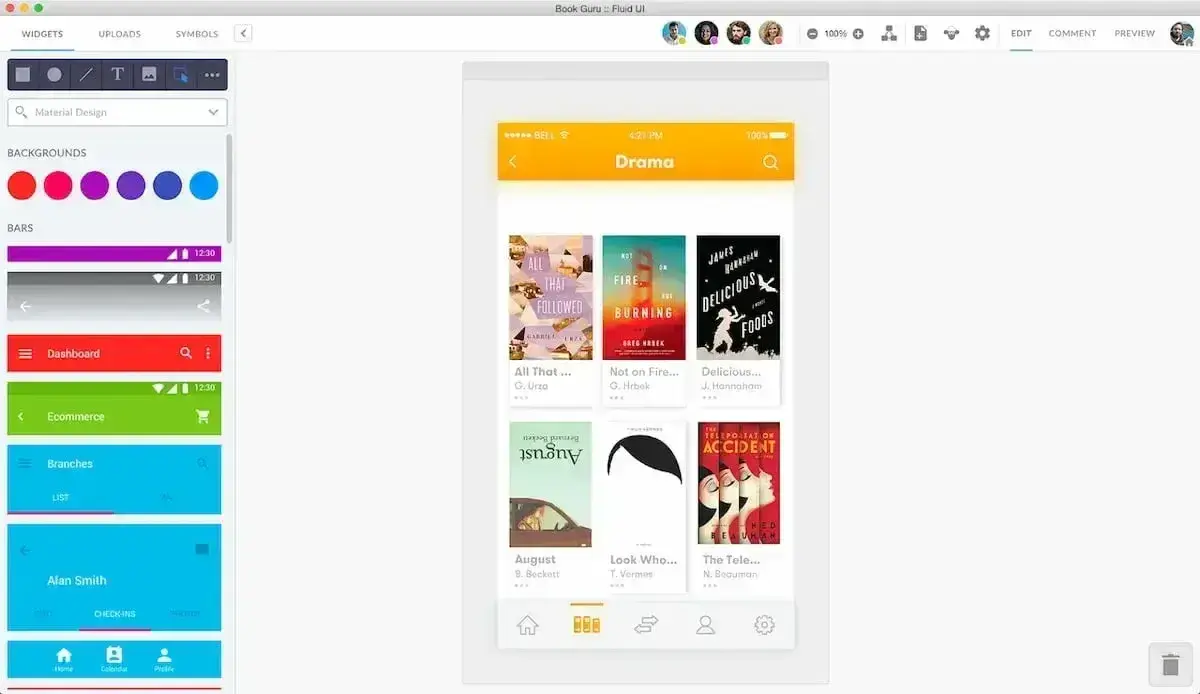
Fluid UI is a free online tool that is ideal for prototyping and building UIs quickly. This tool, combined with the library of standard Apple and Google material assets, enables direct editing in your browser. You can also share prototypes via email and share links so that others can review and leave comments on the page.
Building prototypes only takes a matter of minutes with the assistance of this tool. Plus, you can access it anywhere, whenever you want — whether you are using a desktop app or accessing via a browser.
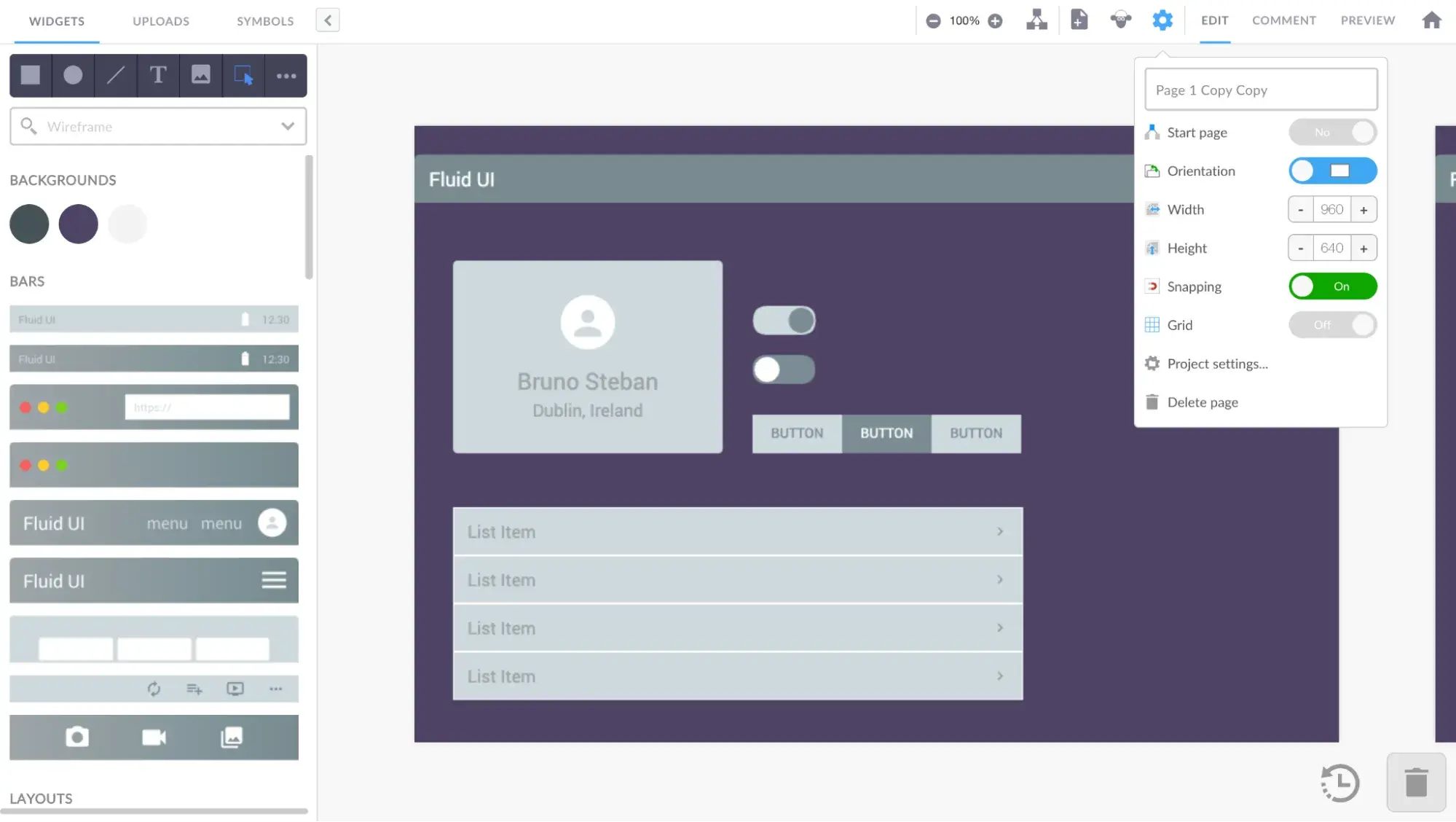
As with a tool like Sketch, I want to make it clear that Fluid UI will not actually create a working website for you. However, I do think that it's very valuable during the web design process because of how easy it is to create prototypes and mockups for your website.
Once you've created your mockup, you could move to create the actual website using free web design software like HubSpot Content Hub, WordPress, or Wix.
Fluid UI Core Functionalities
- User interface design
- Interactive prototypes
- Asset hosting and storage
- Team collaboration features
- Works in a web browser or a desktop client
Fluid UI Pros
- Quick, easy web design freeware for prototypes and wireframing
- Accommodates both high-fidelity and low-fidelity prototyping
- Real-time collaboration and easy sharing
- Works in your web browser but also offers a desktop client if you prefer to work offline
Fluid UI Cons
- The free version is limited — you’re allowed one project with 10 pages and one user
- It is less ideal for higher-fidelity designs, as it's meant for fast iterative prototypes
Why I Picked It
I like Fluid UI because of how quickly it lets you get up and running with an interface design. You can build something in minutes, which isn't always possible with other tools. This means that you can iterate and collaborate right away, which can be really useful for some teams. It also excels when it comes to adding interactivity to your prototypes.
Fluid UI allows for real-time collaboration and easy sharing, making it a great choice for team projects. The free version is limited, with only one project allowed and 10 pages per project. For collaborative projects, paid plans are available.
Code-Free Web Design Software
5. Dorik AI: Best Code-Free AI Web Design Software
Pricing: Free plans are available. Based on annual billing, the Personal plan is $20.75/month, Business is $41.50/month, and for Agency pricing, you have to contact Dorik for details.
OS: Any (web-based)
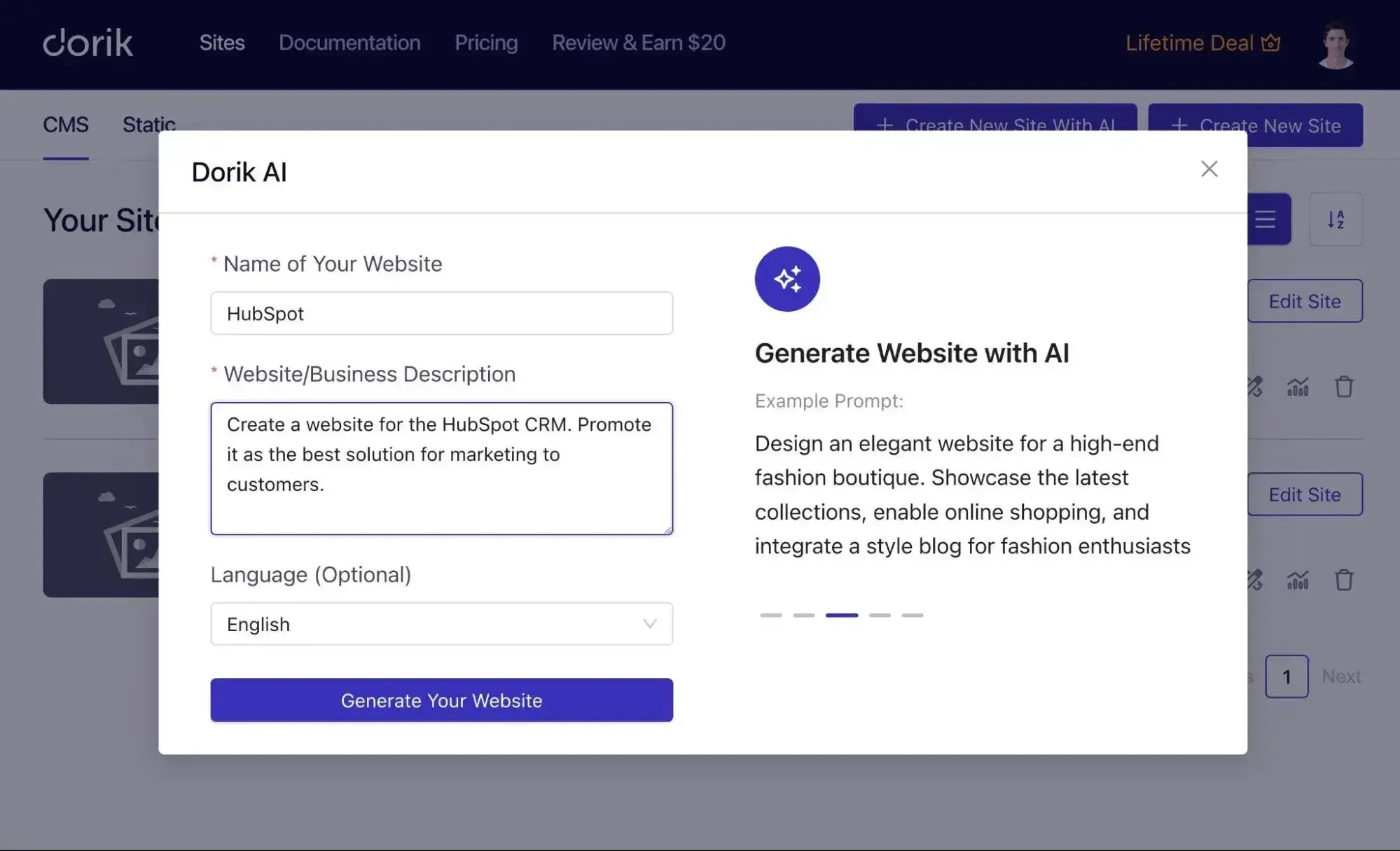
Dorik is a user-friendly AI-powered website builder. You can generate any type of website with a single prompt. The builder features a robust AI text generator and AI image generator, providing copy and photos in a pinch.
Dorik AI generates websites and landing pages using the latest web design principles. For example, you will get a professionally designed header with a relevant menu section, compelling CTAs, complete footer sections, and more. It is also capable of generating relevant sections mentioned in your prompt.
What makes this platform more customizable is its “Regenerate” button. You can regenerate any specific section or the full layout in just a click. You can also regenerate the web copy and images by writing customized prompts.
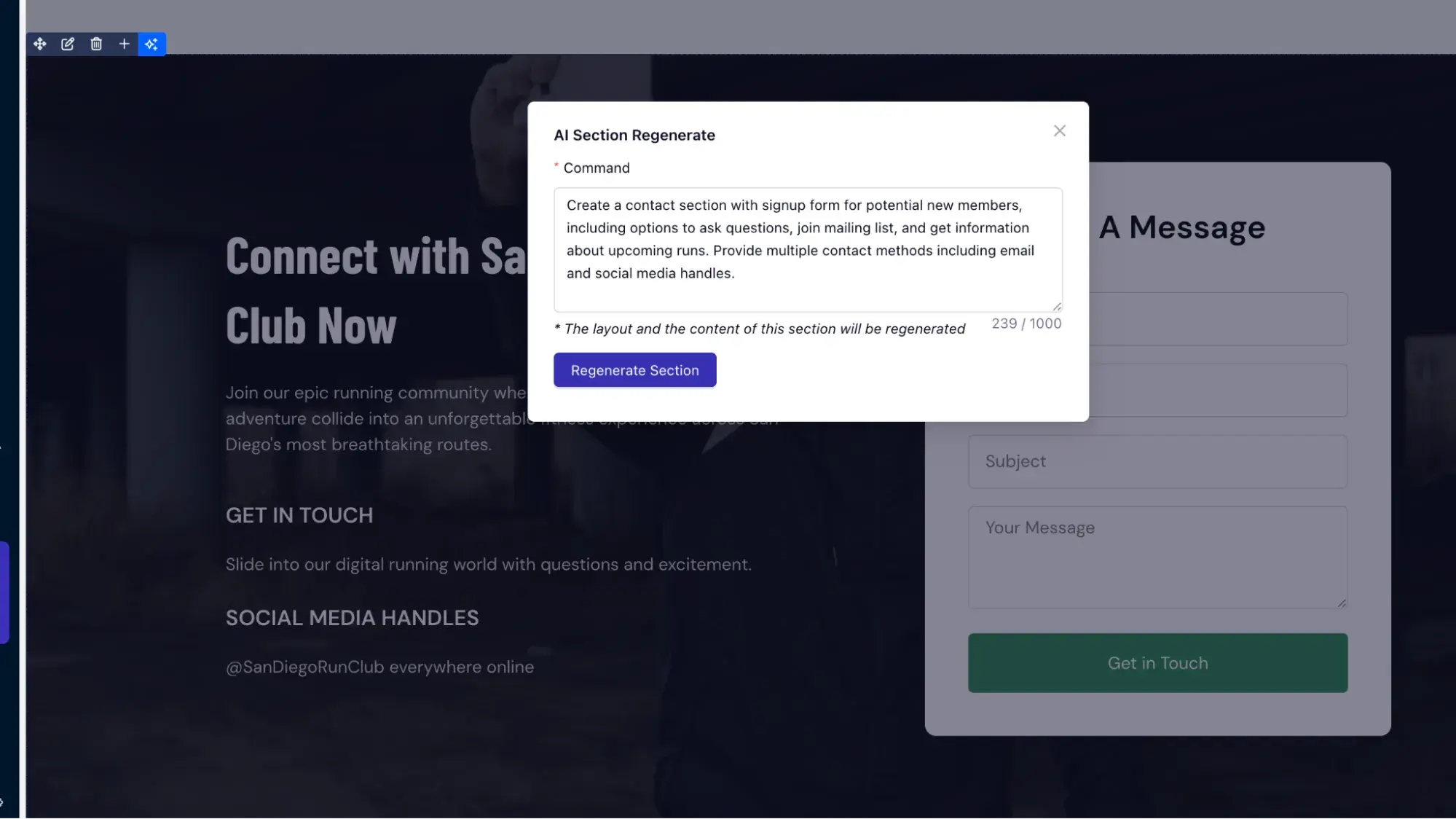
Dorik Core Functionalities
- AI text and image generation
- White-label CMS
- Custom fields and collections
- Regenerate any layout
- Built-in hosting and CDN
- Payment processing
Dorik Pros
- User-friendly interface
- Powerful website editor and no code needed
- Built-in blogging platform with advanced SEO settings
- Use AI to create content and regenerate designs as needed
- Option to export clean code
Dorik Cons
- Limited ecommerce functionalities
- The design customization tools are not as powerful as other website builders, in my experience
Why I Picked It
While I don't personally think full AI website builders are ready for primetime quite yet, you might feel differently. For that reason, I still wanted to include another AI web design tool on this list as an alternative to other web creation tools like WordPress and Wix.
If you want to build a website as fast as possible to get your idea out to the world, Dorik can be a good one to consider.
Dorik is a great option for those who want a fully functioning website in a few minutes. Dorik lets you enhance the functionalities of your website by adding analytics and marketing tools. Dorik ensures that your website will be fast, secure, and optimized for search engines.
Professional Web Design Tools
6. Figma: Best Free Collaborative Wireframing Tool for Beginners
Pricing: Free Starter plan available. Based on annual billing, the Professional plan is $16/month for a full seat, Organization is $55/month for a full seat, and Enterprise is $90/month for a full seat.
OS: Any (web-based)

Figma is professional design software used by skilled web designers and beginners alike. It wasn’t originally a website builder to help you create an actual working website like HubSpot Content Hub and WordPress. Instead, it’s best known as a tool that helps you with web page design, which you could then build using software like Content Hub or WordPress. However, with the 2025 launch of Figma Sites, it’s now possible to design, prototype, and publish a site using Figma.
Best defined as an interface design tool, Figma enables multiple designers to collaborate in real time. As such, it’s an ideal tool if you have various project stakeholders involved in the design process. Figma is a web application, so you won’t need to download a tool to your desktop.
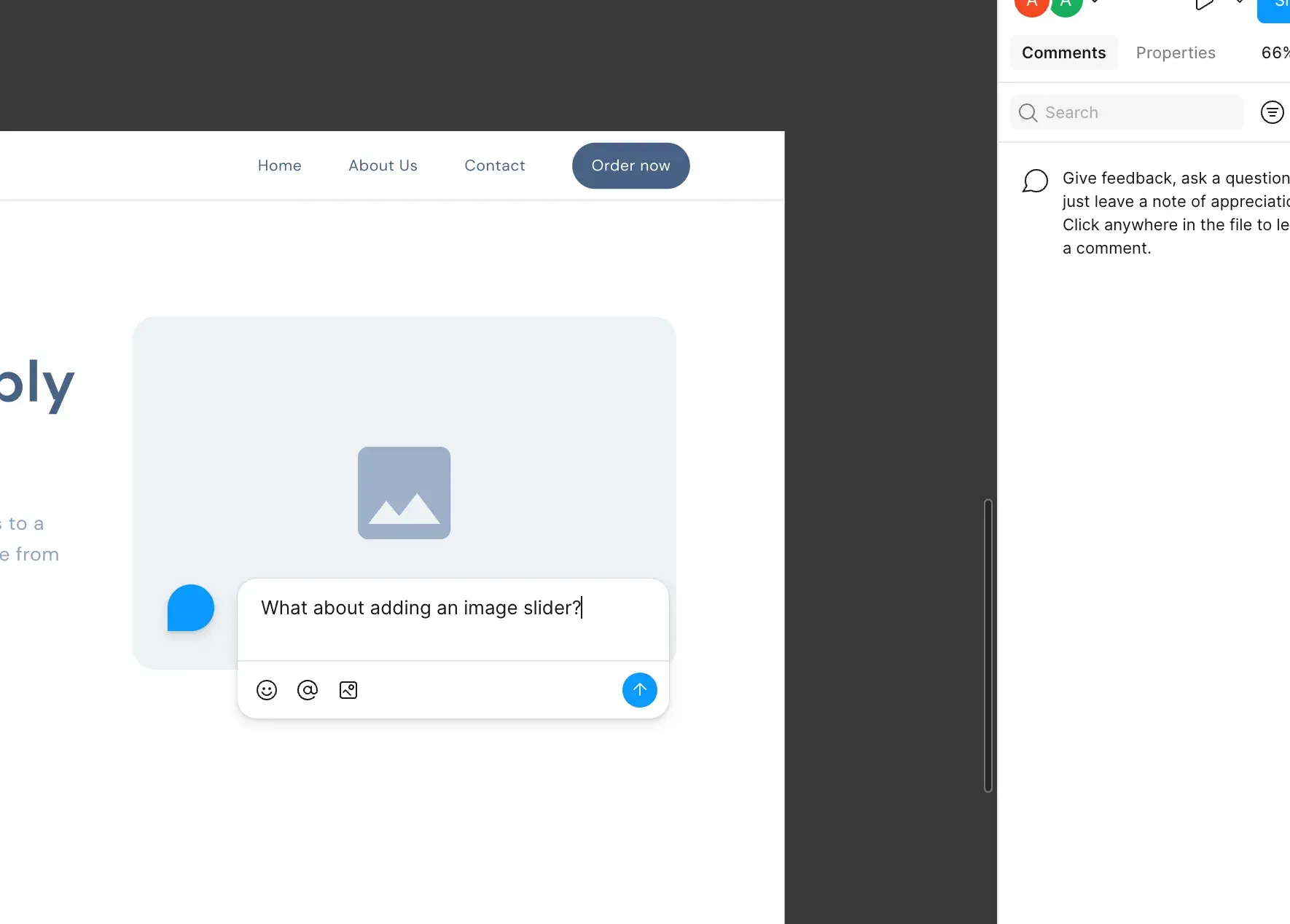
If you use the free version, you get three total Figma Design and Figma Sites files, as well as unlimited drafts.
Landry loves that teams have the ability to try out this web design tool before they commit.
“Since they offered a free version, it made trying and adopting easy,” he says. “By offering a web version, they made collaboration much easier without needing to have an InVision license to let other non-designers comment on your designs. The built-in prototyping allows a designer to create interactive and animated prototypes without the need for additional tools.”
If you upgrade to the Professional tier, you'll get unlimited projects, while the Organization tier gives you access to advanced security and analytics.
Figma Core Functionalities
- User interface design
- Interactive prototype functionality
- Design libraries to ensure consistency across your entire project
- Commenting and real-time collaboration
- Third-party community resources
Figma Pros
- An excellent piece of web design freeware for wireframing, mockups, and prototyping
- Unlimited drafts are allowed on the free version (however, projects are limited)
- Real-time collaboration with team members
- Built-in AI tools can help you generate wireframes and prototypes more quickly
- Tons of third-party templates and packs, which I think can be really helpful when designing a website
- Figma Sites now lets you publish working websites
Figma Cons
- The free version is slightly limited
- The free plan only tracks 30 days of version history, which might be too little for larger projects
- Can experience performance issues, especially over weaker connections
Why I Picked It
Figma is one of the best options for quickly designing great-looking websites and apps. If you already have a tool for actually building and managing your website, adding Figma to your stack will really help with the design part, especially if you need to collaborate as part of a team.
Figma is a solid option for design-oriented professionals who want to collaborate with teammates on wireframing and prototyping. Plus, it has good functionality for both free and premium users.
7. Sketch: Best User Interface Design Tool for Mac Users
Pricing: Based on annual billing, Standard plans cost $12 per editor a month. Business plans cost $24 per editor a month. Mac-only licenses cost $120 per seat.
OS:: macOS
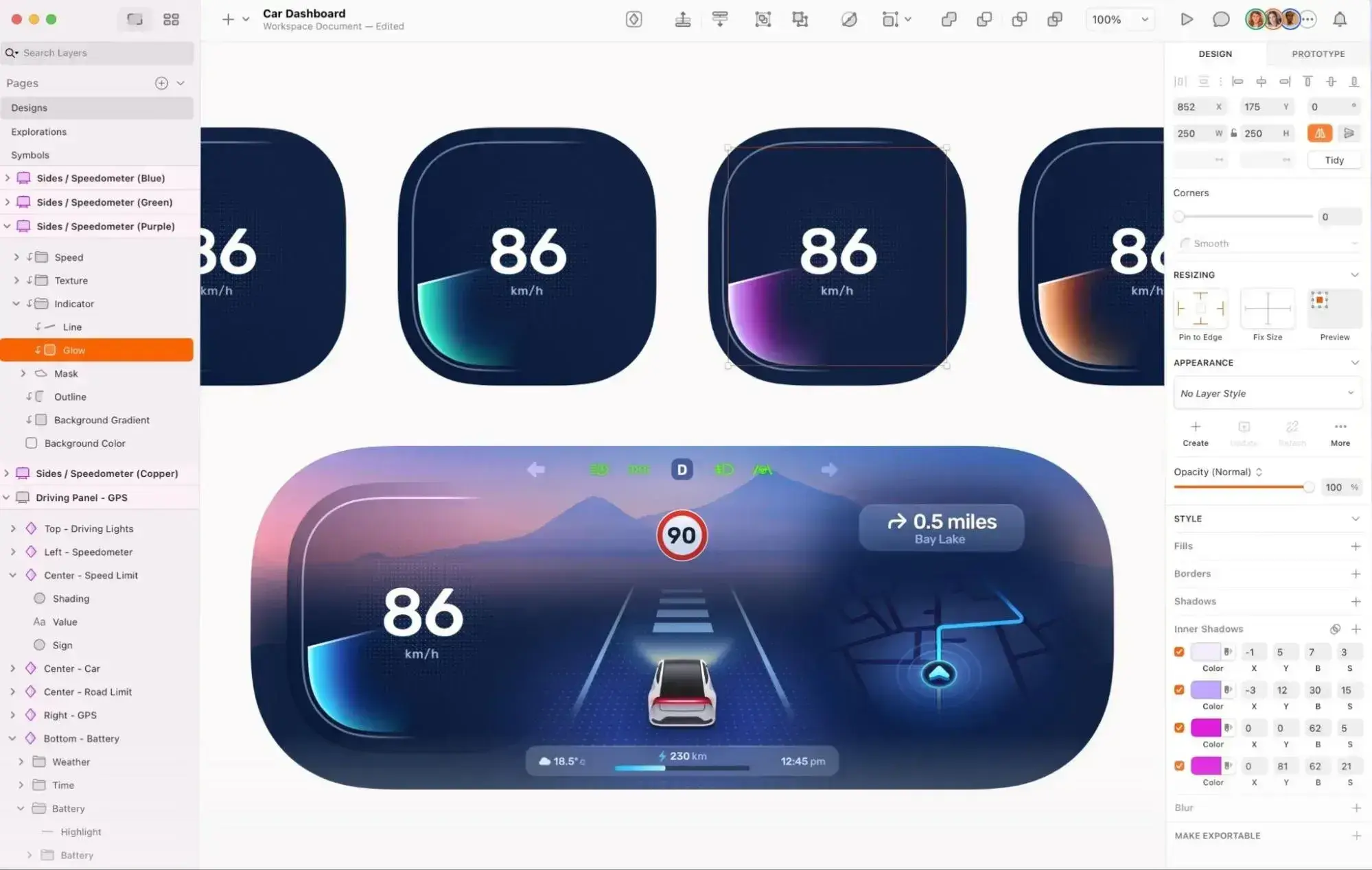
Sketch is one of the most (if not the most) well-known and used UI design tools. It comes with an advanced vector tool, which aids in the collaborative development of interfaces and prototypes. This tool was built particularly for making websites and web apps.
Sketch will not actually create the finished website for you. However, it is an excellent tool that can handle all of the web design process for you. You could then make your finished design a reality using something like Content Hub or WordPress.

Its prominence among the designer community is at least partially due to its clean interface and high performance. However, it only works on Mac. Since many designers work on Windows, you might be better off with a web-based option, such as Content Hub, or a Windows-based option, such as Lunacy.
According to Landry, “[This was the] first vector-based interface design tool that made it easy to design UIs quickly. The ability to save symbols was revolutionary. The integration with InVision made it easy to create prototypes and collaborate with team members. The large library of plugins developed made extending the tool's functionality easy.”
Sketch Core Functionalities
- User interface design
- Collaboration with other team members
- Desktop software (no internet connection needed)
- Component sharing
- Developer hand-off tools for web browser (no Mac needed for this part)
Sketch Pros
- Intuitive, easy-to-use, and popular design tool
- Clean, simple displays for users who hate page clutter
- Handles all phases of the design process from wireframes to prototypes and developer handoff
Sketch Cons
- Free trial only (30 days)
- macOS only
- Weaker collaboration features than other options on this list
Why I Picked It
I had to include Sketch because it’s one of the best web design tools for Mac users. Plus, you can still collaborate with users on other systems thanks to the browser-based feedback interface, so you’re not totally locked into the Apple ecosystem.
If you’re on a Mac, Sketch is the best UI design tool for you. It’s easy to integrate, easy to use, and easy to collaborate with others. It‘s not completely free, as you’ll only get a 30-day free trial. After the free trial, you'll have to pay $12 per editor per month, billed yearly.
How to Choose the Best Website Design Software
With the different free web creation tools on this list, I tried to provide you with multiple options for your next web design project. But with so many options, it might be difficult to choose the best software for your unique situation.
If a specific tool already jumped out at you as the perfect option, that’s great! But if you’re still on the fence, here are some of the things that I think you should consider when making your choice:
- Pure design tool or all-in-one website builder. For the simplest approach, I recommend choosing one of the all-in-one web design tools that can help you both design and publish a website, such as HubSpot Content Hub, Wix, WordPress, and so on. On the other hand, if you just want a pure design tool, look to tools like Figma, Sketch, or Fluid UI.
- Knowledge level. Choose a tool that matches your technical knowledge level. For example, design tools like Sketch are great for skilled web designers experienced with editing vectors, but might be overwhelming for beginners, while website builders like Content Hub are beginner-friendly thanks to their premade templates and drag-and-drop editors.
- Initial and long-term cost. If you ever need to upgrade from the free versions of these tools to the paid versions, make sure to consider both the initial costs and the long-term costs. Some tools might cost more upfront but actually save you money over time.
By factoring in these elements, you can choose the best web design software for your specific situation.
Get Started Today
In curating this list, I was reminded of just how many different ways there are to approach building a website. Whether you're happy working with code or you want a no-code solution for your website, you should be able to find a great tool to help you get the job done.
Once you've chosen the best website design software for your needs, you can browse our website design inspiration lookbook to get some ideas for your project.
Frequently Asked Questions: Free Software Web Design
What is the best website design software for free?
For strictly web design (this means creating wireframes, mockups, and prototypes), Figma is a leading tool for web designers. Its free plan actually lets you do a lot, with access to unlimited drafts, components, advanced drawing tools, interactive prototypes, and enhanced vector editing.
For actually building the website, you can’t beat Content Hub, which is an all-in-one website builder/CMS/web host that has a free plan that lets you build a website using premade templates or AI and then customize it with a drag-and-drop editor (no coding needed). The only thing you’d need to pay for is if you want a custom domain (www.yourdomain.com, for example). Registering a custom domain is something you’d handle outside of Content Hub, but Content Hub lets you connect it for free.
Is there a 100% free website builder?
Yes, HubSpot Content Hub is a 100% free website builder (it also has paid plans if you want to upgrade to premium features). That means you don’t have to pay anything to use the free website templates, edit your website in the visual editor, or host your website on a HubSpot-branded system domain that’s assigned to you. However, the issue you’ll run into is that even if a website builder is free, if you want to choose a custom domain (such as www.yourdomain.com), you have to pay a domain registrar to acquire that.
Is Wix absolutely free?
The Wix free plan lets you use free templates, edit in its visual editor, and host your site on a branded Wix subdomain. However, if you want to connect a custom domain, you must upgrade to a paid plan.
Is Google Web Designer free?
Yes, Google Web Designer is free, but despite its name, it is not made for designing websites. Google Web Designer is made for designing digital ads. If you want to build a website without using code, try starting with a free template from Content Hub or Wix.
Do I need coding skills for web design software?
Typically, no, you do not need coding skills to use web design software. However, there are varying skill levels that different web design tools are best suited for. For instance, Sketch is best used by skilled web designers (those who know how to create vectors), while code-free website builders like Content Hub are made for beginners.
Can I create a professional website with free tools?
While you could create a professional website with free tools, I highly recommend paying to remove any branding and to connect a custom domain. For example, the free version of Wix will include the Wix logo on it, which can take away from the professional image. But if you upgrade, you can remove that branding.
Will I be limited by free web design tools?
Free web design tools often only offer limited features. For example, Figma's free plan lets you create unlimited drafts and use components and advanced drawing tools. But to access team libraries, design productivity tools, and organization-wide design systems, you need to upgrade to a paid plan. Free website builders will often place branding on your finished site. Content Hub's free plan grants you up to 30 total website pages with HubSpot branding, mobile optimization, custom domain connection, design manager, Breeze Assistant (AI), drag-and-drop editor, forms with limited features, and live chat with HubSpot branding. To remove all HubSpot branding, you need to upgrade to a paid plan.
Editor's note: This post was originally published in June 2020 and has been updated for comprehensiveness.
Website Design



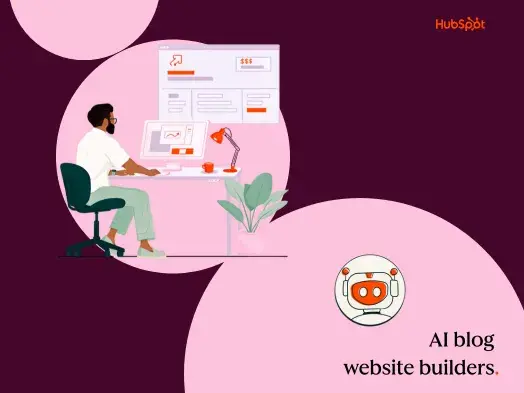




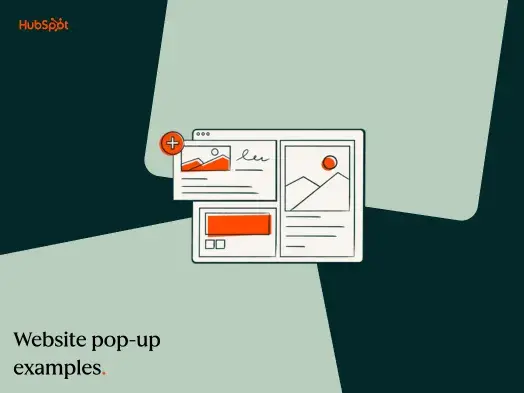
![Creating a Web Design Contract That Keeps Your Project on Track [+ Expert Tips]](https://53.fs1.hubspotusercontent-na1.net/hubfs/53/web-design-contract-1-20250312-1603286.webp)

![The Podcaster's Guide to Embedding Your Show on Your Website [+Step-by-Step Tutorial]](https://53.fs1.hubspotusercontent-na1.net/hubfs/53/embed-podcast-on-website-1-20250226-2656001.webp)
